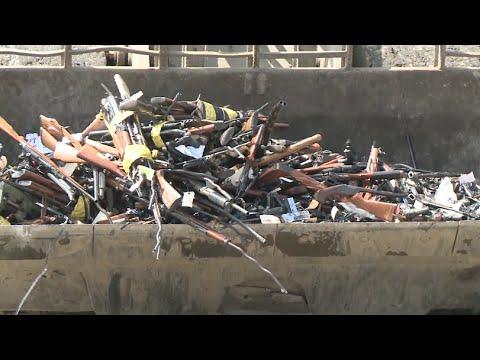Combating Urban Gun Violence: Innovative Approaches to Firearm Reduction and Community Safety
Understanding the Toll of Gun Violence on City Life
Gun-related violence profoundly disrupts urban environments, extending far beyond the immediate tragedy of lost lives. It undermines community cohesion, breeds mistrust among residents, and stifles economic vitality. Educational institutions often become arenas of trauma rather than learning, while entrepreneurs hesitate to invest in neighborhoods plagued by insecurity. This pervasive atmosphere of fear perpetuates a cycle of instability that impacts families and neighborhoods across generations.
Tackling this multifaceted crisis demands comprehensive strategies, including the targeted removal and destruction of illegal firearms circulating within communities. Residents seek solutions that enhance safety while respecting individual freedoms. The following data illustrates how reducing the availability of guns correlates with measurable improvements in community health and stability:
| Indicator | Prior to Gun Reduction | Following Gun Reduction |
|---|---|---|
| Homicide Rate (per 100,000 residents) | 27.1 | 16.3 |
| Business Closure Percentage | 20% | 8% |
| Annual PTSD Diagnoses | 480 | 290 |
Effective collaboration among policymakers, law enforcement, and community advocates is essential to dismantle illegal gun networks while simultaneously investing in mental health services, educational outreach, and economic development to nurture safer, thriving neighborhoods.
Blueprint for Successful Firearm Collection and Destruction Initiatives
The cornerstone of impactful gun destruction programs lies in the seamless cooperation between police departments, civic leaders, and municipal authorities. Transparency and community involvement are critical to building trust and encouraging participation. Initiatives that feature secure drop-off locations, widespread public education, and convenient surrender options have proven effective in increasing voluntary firearm turn-ins and reducing gun-related incidents.
Furthermore, alliances with firearm manufacturers and accredited destruction facilities ensure that collected weapons are permanently disabled, preventing their return to circulation. Complementing these efforts with rigorous data analysis allows stakeholders to monitor progress and refine strategies.
| Key Element | Objective | Outcome |
|---|---|---|
| Secure Surrender Sites | Provide safe, accessible locations for gun turn-in | Boosted community engagement |
| Educational Campaigns | Raise awareness and encourage participation | Higher voluntary firearm collection rates |
| Certified Destruction Processes | Guarantee permanent deactivation of firearms | Minimized risk of gun recirculation |
| Law Enforcement Coordination | Streamline collection and enforcement efforts | More effective targeting of illegal weapons |
| Data-Driven Evaluation | Measure program effectiveness and guide improvements | Informed policy decisions |
Fostering Community Partnerships and Strengthening Police Relations
The safety of urban areas depends not only on law enforcement’s capacity to confiscate illegal firearms but also on cultivating enduring relationships with residents. Collaborative efforts have led to the creation of neighborhood advisory councils, empowering citizens to express concerns, share intelligence, and engage in customized intervention programs. These initiatives emphasize openness and mutual respect, transforming passive observers into active contributors in the fight against gun violence.
- Frequent community forums with police leadership to review strategies and outcomes
- Resident-driven awareness initiatives promoting responsible firearm surrender and destruction
- Joint training programs enhancing officers’ cultural sensitivity and responsiveness
Enhanced data-sharing agreements between law enforcement and community groups have significantly improved the identification and disruption of criminal networks. These partnerships have contributed to notable declines in gun-related offenses and expedited case resolutions through pooled resources and intelligence.
| Program | Effect | Stakeholders |
|---|---|---|
| Neighborhood Advisory Councils | Increased trust and 35% rise in tip submissions | Residents, Police, Community Organizations |
| Firearm Surrender Campaigns | Over 1,500 illegal guns removed | Community Members, Law Enforcement |
| Collaborative Training Sessions | Response times improved by 22% | Officers, Community Leaders |
Policy Actions to Strengthen Urban Safety and Reduce Gun Violence
To effectively protect city residents, law enforcement must implement robust gun buyback initiatives alongside comprehensive firearm sale regulations. These policies incentivize the voluntary surrender of weapons, thereby diminishing the prevalence of illegal firearms. Additionally, allocating greater resources to community-based violence prevention programs addresses underlying issues such as economic disparity and educational deficits.
Legislative reforms should focus on closing existing gaps in firearm laws by emphasizing:
- Universal background screenings for all gun transactions, including private sales
- Mandatory waiting periods to reduce impulsive acts of violence
- Comprehensive tracking and reporting of lost or stolen firearms
- Investment in cutting-edge surveillance technologies that support law enforcement while safeguarding civil rights
| Policy Measure | Expected Outcome | Implementation Timeline |
|---|---|---|
| Gun Buyback Programs | Decrease in illegal firearm circulation | Short Term (6-12 months) |
| Universal Background Checks | Prevention of firearm access by prohibited individuals | Within 1 year |
| Community Violence Intervention | Lower rates of repeat offenses | Medium Term (2-3 years) |
Final Thoughts: Building Safer Cities Through Collective Action
As national conversations around gun control continue to evoke strong opinions, the proactive dismantling of illegal firearms in urban areas exemplifies a forward-thinking approach to public safety. While obstacles persist, these initiatives highlight a dedication to reducing gun violence and fostering secure, vibrant communities. The ongoing success of such programs depends on sustained community involvement, effective law enforcement collaboration, and open dialogue balancing individual rights with collective responsibility. Ultimately, safeguarding our cities requires not only removing weapons but also nurturing trust and cooperation among all residents.













